#Voyager Fishing Co Ltd
Text
Storbritanniens största fiskebåtar 2022
Storbritanniens största fiskebåtar 2022
De största fiskebåtarna i Storbritannien är i huvudsak pelagiska fiskebåtar som är hemmahörande i Fraserburgh, Peterhead och på Shetlandsöarna. De sistnämnda kan ha Lerwick eller nån hamn på ön Whalsay som exempelvis Symbister som hemmahamn. Den allra största båten är dock en demersal fiskebåt, H 72 Frank Bonefaas. Den enda övriga stora demersala fiskebåten är H 7 Kirkella. De flesta stora…
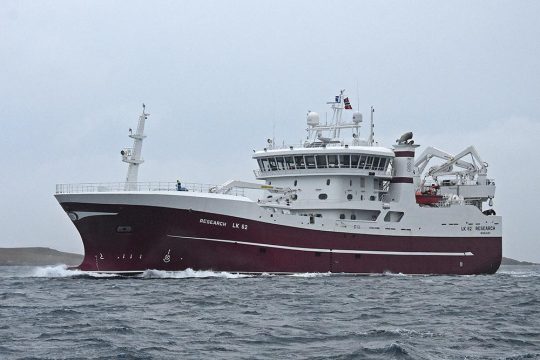
View On WordPress
#Andrew Marr International#BF 60 Artemis#Cornelis Vrolijk#FR 77 Ocean Star#Fraserburgh#H 7 Kirkella#H 72 Frank Bonefaas#Interfish#Klondyke Fishing Co Ltd#Lerwick#LK 297 Serene#LK 362 Charisma#LK 491 Antares#LK 62 Research#Londonderry#Mewstead (Fraserburgh) LLP#N 905 Voyager#North Atlantic Fishing Co Ltd#PD 65 Lunar Bow#Peterhead#Serene Fishing Co Ltd#UK Fisheries#Voyager Fishing Co Ltd#Whalsay
0 notes
Text
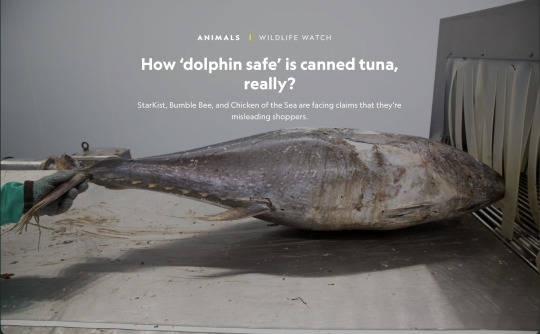
A frozen tuna enters a cleaning machine at the Grupo Pinsa processing plant in Mazatlán, Mexico. Tuna from Mexico is restricted from being sold in the U.S. with a dolphin safe label because some fisheries in the region continue to chase and net dolphins when catching the fish. PHOTOGRAPH BY SUSANA GONZALEZ/BLOOMBERG VIA GETTY IMAGES
— By Rene Ebersole | March 10, 2021 | National Geographic
Jennie Dusheck makes a habit of preparing for the worst. When the California writer realized a few years ago that wildfires and smoke-filled air were becoming an annual inevitability, she bought Israeli gas masks in case it became difficult to breathe. In December 2019, when many West Coasters were looking forward to heavy snow forecasts for skiing, she fretted about the threat of mudslides and wrote an article about how to survive one. With the news of a mysterious disease in China the following February and concerns about food shortages if it spread to the U.S., Dusheck hurried to the grocery store to stock up on staples—pasta, peanut butter, nuts, sardines, tuna.
She felt a little guilty about the tuna, “because there aren’t a lot of fish left in the sea,” she says. “But it was an indulgence that would keep—and I wanted something besides walnuts.”
Of course, Dusheck wasn’t the only pandemic prepper stockpiling tuna. Early on, canned tuna sales doubled. In July 2020, the Wall Street Journal reported that the increased demand for tuna, compounded by pandemic-related port closures and worker quarantines, was challenging some tuna companies to keep up.
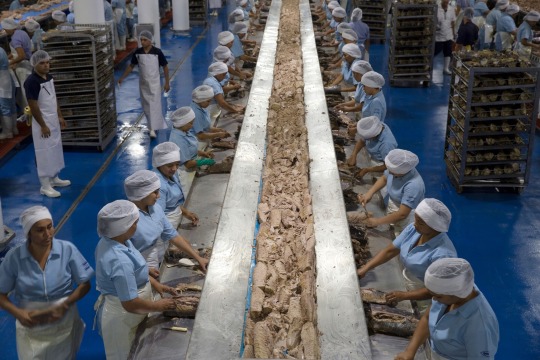
The majority of tuna arrives at processing facilities frozen. After thawing, the fish is steam-baked to allow for easy removal of the skin and bones. Workers seen at the Grupo Pinsa processing plant in Mazatlán, Mexico, are cleaning the meat, which will be cooked a second time before it’s machine-packed in cans. PHOTOGRAPH BY SUSANA GONZALEZ/BLOOMBERG VIA GETTY IMAGES
While the pandemic has been a boon to business, tuna companies have for years struggled with declining sales and perceptions about their product being tainted with toxic mercury, harmful to the environment, and passé with millennials. The newfound popularity of tuna hasn’t freed the longtime staple from controversy, however. The three largest U.S. tuna brands—StarKist, Bumble Bee, and Chicken of the Sea, which collectively account for up to 80 percent of the national market—are facing class action lawsuits claiming that they’re defrauding shoppers with marketing campaigns touting dolphin safety and a commitment to sustainability.
The suits come on the heels of a price fixing scandal involving the big three working together to sell their products at inflated costs. StarKist, acquired by Dongwon Industries in South Korea, pleaded guilty and was fined $100 million. Bumble Bee, recently purchased by the Taiwan seafood conglomerate FCF Co, Ltd., also pleaded guilty and was fined $25 million. The company’s former chief, Christopher Lischewski, who maintained his innocence, is now serving 40 months in a federal prison in Tucson, Arizona. Chicken of the Sea, owned by Bangkok seafood seller Thai Union, was granted amnesty for blowing the whistle on the others.
The dolphin-safe court battle could drag on for years, but it raises important questions for consumers aiming to buy products that are environmentally friendly and socially responsible. (Here’s what the different labels on tuna cans mean.)
“People often see a label on a can and think things are taken care of,” says Ryan Bigelow, senior manager of the Monterey Bay Aquarium’s Seafood Watch program, which makes science-based, sustainable seafood recommendations to grocery shoppers. “The reality is there’s often still a lot more work to be done.”
Gone Fishing
Scientists say there’s one inescapable certainty in any type of commercial fishing: incidental bycatch, the lackluster term for marine life—from whales and dolphins to sharks, seabirds, and endangered sea turtles—unintentionally hooked or ensnared in nets. Fishing methods associated with dolphin bycatch include gillnets, purse seine nets, fish aggregating devices, and longlines.
Each name fittingly describes how the technique works. Gillnets are made of mesh that snags fish by their gills as they swim through it. Purse seine nets encircle schooling fish, which become trapped when the net is cinched, or “pursed,” by a metal cable from the bottom. Often used in combination with purse seines, fish aggregating devices (FADs) are floating rafts attached to a sonar-equipped satellite buoy; they take advantage of the natural tendency for fish to congregate beneath such things as logs drifting in the ocean. Longlines trail up to 50 miles of fishing rope baited with thousands of hooks.
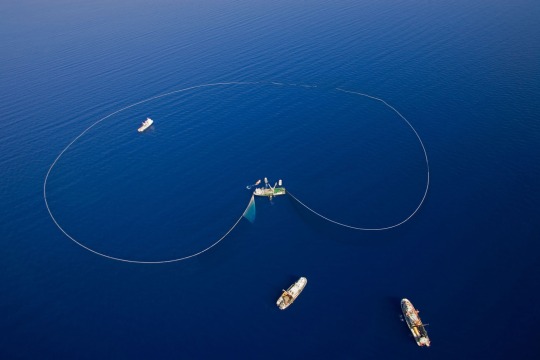
Turkish fishing boats deploy a purse seine net to surround a school of bluefin tuna in the eastern Mediterranean Sea. Bluefin tuna, highly prized for sashimi, are in steep decline from overfishing. Globally, there are 15 species of tuna; albacore, yellowfin, and skipjack are favored for canning. PHOTOGRAPH BY GAVIN NEWMAN, ALAMY STOCK PHOTO
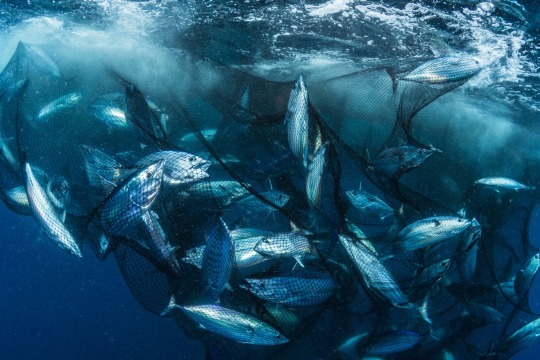
A purse seine net traps a school of skipjack near North Sulawesi, Indonesia. Globally, many tuna fisheries use purse seines, fish aggregating devices (FADs), and longlines—methods that indiscriminately kill dolphins and other marine life as bycatch. When buying canned tuna, choose pole-caught or troll-caught varieties. PHOTOGRAPH BY SHANE GROSS / NPL VIA MINDEN PICTURES
The volume of dolphins and other marine life caught as bycatch from these fishing methods is “staggering,” says Zak Smith, an attorney with the Natural Resources Defense Council who contributed to a 2014 report titled Net Loss: The Killing of Marine Mammals in Foreign Fisheries. The report cites data estimating that 650,000 marine mammals including dolphins, whales, and seals are caught or seriously injured in fisheries every year. “Three hundred thousand of those animals are cetaceans [whales, dolphins, and porpoises],” Smith says, “and the vast majority of them are dolphins because there are a lot more dolphins than anything else.”
The Indian Ocean and the eastern tropical Pacific Ocean—770,000 square miles of blue water and archipelagos off the coast of Ecuador, Panama, Costa Rica, and Columbia— are infamous for dolphin bycatch. In the Indian Ocean, scientists estimate that four million dolphins have died in the region’s poorly regulated gillnet fisheries since the 1950s. The researchers report that roughly 80,000 dolphins are now killed as bycatch annually.
In the tropics of the eastern Pacific Ocean, fishermen have long used dolphin schools as living fish finders, signaling a tuna payload in the deep. This is the only region in the world where a commercial fishery overlaps with the unique, and poorly understood phenomenon of spotted, spinner, and other species of dolphins routinely swimming with schools of yellowfin tuna.
In the old days, seamen chummed the dolphin-rich waters with baitfish, drawing tuna to the surface, where they could hook them with poles. By the late 1950s, however, bait fishermen had widely switched to purse seining, and they commonly targeted and chased the dolphins to corral their tuna catch in the center of nets that could be up to a mile long and 80 feet deep. Scientists estimate that more than six million dolphins were killed by eastern tropical Pacific tuna purse seiners in the three decades before the mid 1990s.
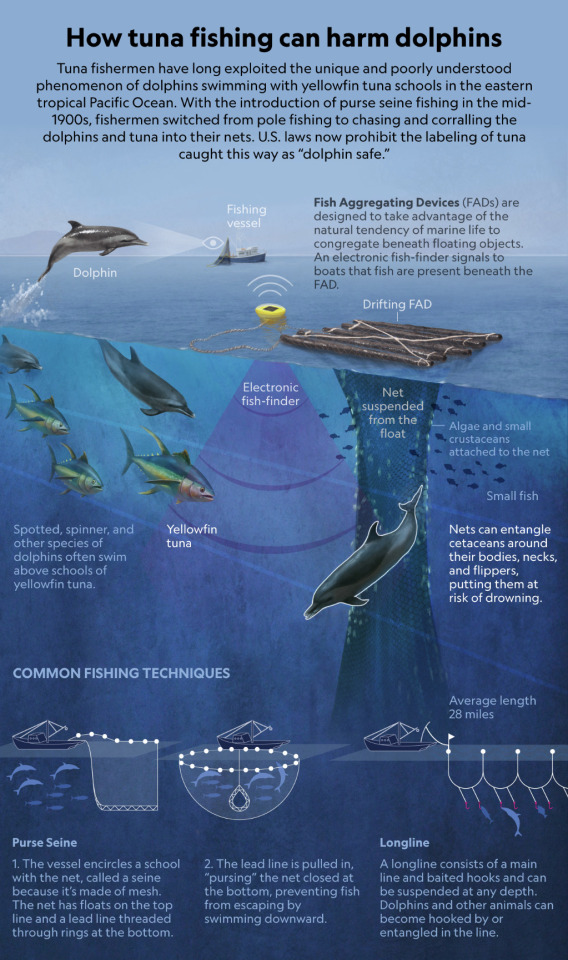
The tipping point came in 1987, when a 31-year-old biologist named Samuel LaBudde (pronounced “LaBuddy”) went undercover as a cook on a Panamanian tuna vessel. On a four-month voyage, he filmed hundreds of dolphins dying as they were hefted from the ocean.
"Drowned or snagged in the net, the dolphins fight a losing battle for life," LaBudde said, narrating the graphic video, broadcast on television and presented before the U.S. Congress. "Some will fall back into the sea as flippers and beaks are broken or ripped out of their bodies, only to become ensnared moments later and be pulled out once again."
Public outrage led to an amendment of the U.S.’s Marine Mammal Protection Act to better protect dolphins and one of the most successful consumer boycotts in national history. “It infected people with a sense of injustice and anger,” LaBudde says. “Thousands of school children refused to eat canned tuna.” In response to the uproar, the big three U.S. tuna companies proclaimed in 1990 that they would not purchase any tuna captured in nets along with dolphins.
Furthermore, the newly signed Dolphin Safe Consumer Information Act of 1990 made it illegal for any tuna product exported from or sold in the U.S. to claim that it’s “dolphin safe” unless it’s in compliance with a bevy of complex U.S. laws and regulations designed to protect dolphins. Demand for dolphin-safe tuna in the U.S. drove many fisheries to adopt the standards, but tuna caught in association with dolphins continues to be sold in Latin America, Asia, and some European countries.
“The U.S. dolphin safe program has been very effective,” says Sara McDonald, a senior fisheries scientist at Monterey Bay Aquarium. “Dolphin mortality in the 1980s was 130,000. In 2018, there were 819 documented deaths. If your product has a dolphin safe label, you are legally obligated not to sell tuna where dolphins were injured, killed, or set upon. It doesn’t mean dolphins aren’t interacting with the tuna fisheries; it means that tuna can’t be sold in this country.”
Accusations of Fraud
The Natural Resources Defense Council’s Smith says he believes that most tuna sold in the U.S. with a dolphin-safe tuna seal is legitimate, but because tuna is a global commodity with very long supply chains, there are opportunities for fraud and deception. “The U.S. laws are good if everyone is being honest,” he says. “But that doesn’t mean nothing ever gets in. There is an incredible amount of illegal wildlife moving into the country. [Law enforcement] can’t catch it all.”
The dolphin-safe tuna class action suits charge that the tuna companies are not being honest about the integrity of their supply chains. More broadly, they allege that the companies have run pervasive advertising campaigns that lead consumers to trust that the companies “never” kill dolphins. For example, the group of people suing Starkist allege that parent company Dongwon’s distant water boats often entrap dolphins, because many are purse-seine fishing vessels that use fish aggregating devices to capture tuna. (Neither purse seine nets nor FADS are banned under U.S. dolphin-safe fishing standards.)
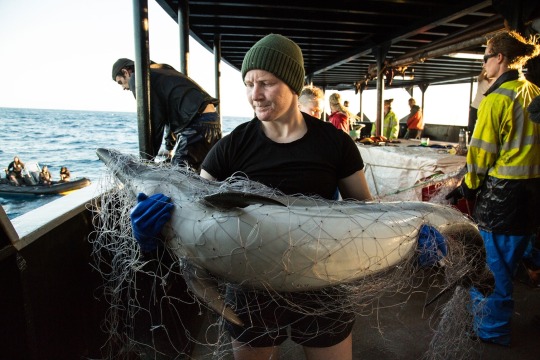
A crew member on the Steve Irwin, the flagship vessel of the conservation nonprofit Sea Shepherd, cradles a common dolphin killed by an illegal drift net in the South Indian Ocean during the group's Operation Driftnet campaign. The UN banned drift nets in 1992 because they kill non-target fish and other wildlife such as sea turtles. PHOTOGRAPH COURTESY OF ELIZA MUIRHEAD / SEA SHEPHERD GLOBAL
“Either the companies should stop accepting tuna from these fishing practices or be up front with consumers that they’re not dolphin safe, even though they may be in compliance with the law,” says Stuart Davidson, one of the lead plaintiff attorneys in the lawsuits. “We want restitution for everyone in the country who paid more than they should have because the tuna was caught with these methods.”
StarKist officials, according to court documents, say it’s unrealistic for consumers to expect that the label means zero harm or injury to dolphins and other wildlife because bycatch is an inescapable reality of any fishery, no matter whether tuna is caught with purse seines or more dolphin-friendly poles—a reality that’s accepted and acknowledged under the Dolphin Protection Consumer Information Act.
Bumble Bee and Chicken of the Sea did not respond to interview requests. A StarKist spokesperson would not comment on the litigation but provided a statement about the company’s commitment to protecting dolphins. “StarKist does not purchase any tuna caught in association with dolphins,” the spokesperson said, and “condemns the use of indiscriminate fishing methods that trap dolphins, whales, and other marine life along with the intended catch of fish.”
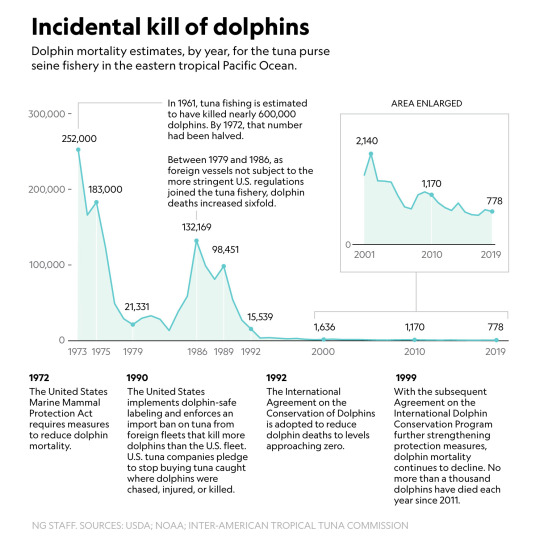
Peeling Back the Labels
As a federal court in California weighs the dolphin-safe lawsuits, sustainable seafood experts offer guidance on how to buy canned tuna that is not only dolphin safe but also environmentally friendly and socially responsible.
“The misconception is if it’s not hurting dolphins, then it must be okay,” says oceans expert and renowned environmental author Carl Safina, who spearheaded a sustainable seafood guide when he was working for the National Audubon Society in the 1990s. “But the reality is it’s likely to be hurting some other non-target species in a big way, or simply depleting the species. The overwhelming majority of tuna populations are overfished.”
Buying sustainable seafood pushes retailers to source environmentally responsible products, which can drive improvements throughout the industry, say Monterey Bay scientists involved with the aquarium’s Seafood Watch consumer guide.
In the case of canned tuna, McDonald says it’s best to read labels for descriptions such as “pole-caught” (fishing one tuna at a time) and “troll-caught” (fished by a slow-moving boat dragging lure lines). “Anything else is less sustainable,” she says. “These fisheries have better control of what they’re catching. There’s also a higher survival rate for the bycatch that they throw back.”
The nonprofit activist group Greenpeace has worked for many years to bring to light the environmental and human rights issues associated with tuna fisheries, including dolphin mortalities, endangered sea turtle and shark bycatch, debt bondage, human trafficking, and forced labor. Taking these factors into account, Greenpeace evaluated the sourcing policies and practices of 20 canned tuna brands and published them in a Tuna Shopping Guide.
StarKist, Chicken of the Sea, and Bumble Bee were among the lowest ranked brands featured in the guide. The four top-rated tuna companies were Wild Planet and American Tuna, which tied for first place, followed by Whole Foods and Ocean Naturals. Selling only pole-caught fish, American Tuna supports local and small-scale fishing and production in the U.S. Wild Planet procures pole- and troll-caught tuna from sustainable fisheries in the U.S., Japan, New Zealand, Spain, Portugal, and the archipelago of Cape Verde off Africa’s northwestern coast.
Shoppers pay a premium—up to six dollars a can—for eco-friendly tuna brands. Wild Planet founder Bill Carvalho says the higher cost is unavoidable because there’s more labor involved with sustainable fishing. “You can’t do this for 59 cents a can,” he says. “Cheap tuna comes at an astronomically high environmental price. They’re dumping endangered species overboard.”
Safina says he tends to avoid eating tuna—with two exceptions. The first is if he catches it himself. “These fish are the most superb animals. When you kill one and turn it into food, it’s precious,” he says. “If you handle it well and use it as sashimi or put it on the grill and cook it just right, it’s just phenomenal.” Second, if it’s pole-caught. “I have a philosophy that it’s good to support the good actors,” he says. “Even if the good actors are within a bad fishery.”
Many consumers are now left with the question of what to do with all the tuna that they stockpiled—Google searches for canned tuna recipes have soared by 300 percent. Writer Jennie Dusheck has no plans to cook tuna lasagna, fish cakes, or noodle casserole. She’s enjoying her “indulgence” with lettuce, red pepper, celery, and lime juice on some good sourdough bread.
2 notes
·
View notes
Photo



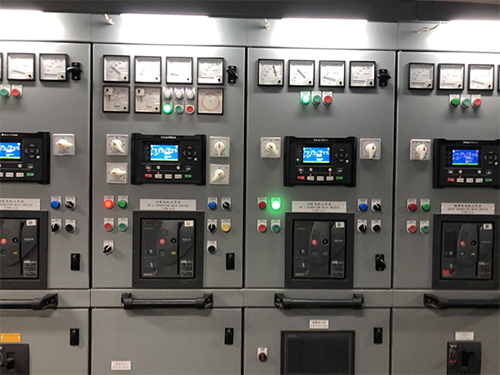

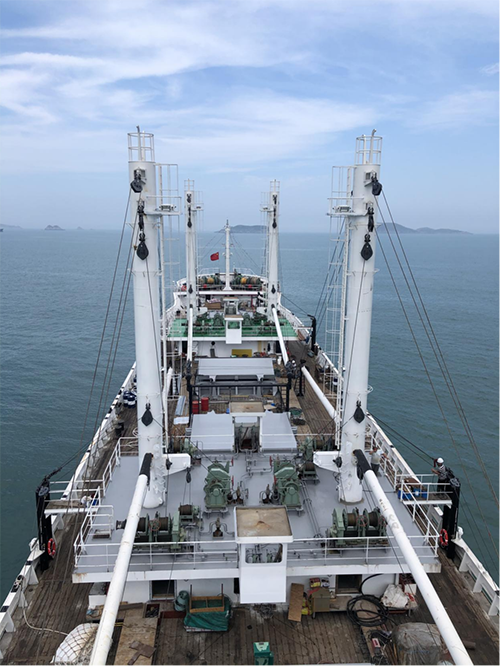
SmartGen | We Helps 123m Reefer "Fuyuan Yuyun 266" Go to Sea
Recently, 123m reefer "Fuyuan Yuyun 266" has completed first open sea operation and returned with full cargos. It is built by Fujian Changxing Shipbuilding Heavy Industry Co., Ltd. It is 123.30 meters in length, 18.50 meters in width, 10.50 meters in depth, 6.80 meters in design draft, 7000 tons in deadweight, 14.5 knots in service speed with 4 refrigerated fish holds, which is the first reefer built according to unlimited navigation area standard in Fujian Province and the largest reefer currently in Fujian area.
Launching Ceremony of "Fuyuan Yuyun 266" Ship
"Fuyuan Yuyun 266" after Trial Trip
Its main switchboard adopts 4 SmartGen HMC6 multi-master power management controllers to realize automatic scheduling and protection between 3 DGs and 1 SG. SG can stably parallel with diesel genset to supply power for load during open sea voyage. During the debugging process of power station, SmartGen personnel works together with the manufacturer of main switchboard, project manager of shipyard, shipowner’s representatives and genset manufacturer to ensure the power station passes acceptance of Classification Society with high standard. This is another successful application of SmartGen marine control products in marine automatic power station field.
Main Switchboard of 123m Reefer "Fuyuan Yuyun 266"
123m Reefer "Fuyuan Yuyun 266" Power Management System Composed of 4 HMC6
SmartGen Marine Engine Control & Power Station Power Management Solution Diagram
After more than 10 years of unremitting efforts, the fully domestic marine engine intelligent control and power station power management solution formed by the combination of MGCP100B/L-2 diesel engine control box and HMC6 power management controller specially developed by SmartGen for marine diesel engine, is widely applied in offshore platforms, offshore wind power booster stations, luxury yachts, public service ships, ro-ro passenger ships, container ships, bulk ships, crude oil carriers, refined oil carrier, full-rotating tugs and other ships. The products have been highly praised by end users.
SmartGen full series marine products have passed BV type approval in March, 2021. By now, SmartGen marine engine controller, distributed IO module, MGCP100B/L-2 series diesel engine control box, HMC6 power management system and power protection module have been certified by CCS and BV.
www.smartgen.cn
0 notes
Text
Powered Catamaran Market Global Overview 2020 | Forecast till 2027
Summary:
A recent development in design such as configuration fills in niche powered vessels, where the speed and sea kindliness is favored with bulk capacity, has led to introduction of power catamaran. It incorporates features of a motor yacht and combines it with conventional sailing characteristics of a multi-hull. These catamarans are designed with low clearance and significantly with better speed and range than a conventional catamarans.
Market Drivers
Conventionally, powered catamarans were used for racing or sports purposes, however, over the past few years these have been manufactured for cruising application due to technological advancement such as enhanced speed and safety features coupled with increased stability, which has led to increased adoption of powered catamarans for various applications.
Along with sports and cruising, powered catamarans are also been utilized for other applications such as passenger transport and military. Advancements in terms of reliability and enhanced speed and stability such as powerful engines and durable body of the hulls has aided powered catamarans to scale large distance in shorter time periods and offer enhanced comfort and safety.
Moreover, it is light weight and offers efficient performance. These are the factors driving Powered Catamaran Market growth.
Market Restraint
Major factor expected to restraint growth of the powered catamaran market is stringent environment protection regulations. Stringent government regulation regarding oil and fuel discharge and other harmful chemicals and toxins is among the major factor expected to hinder the global market growth during the forecast period.
For instance, according to Federal Refuse Act, the discharge of fuel, oil, oily wastes, and hazardous substances is completely prohibited into the waters of the U.S. or the waters of the contiguous zone. In addition to this, under state law F&GC 5650 prohibits discharges of petroleum and other substances harmful to fish, plants, mammals, and birds.
High investment is a major barrier for growth of the industry. A substantial number of powered catamaran manufacturers seem to face cash flow problems and have difficulties financing their business. In this business model, companies need to purchase components and assemble their crafts, before it can be sold as an end product. Hence, manufacturer needs to invest high amount initially for the production.
Request for the Sample copy @ https://www.coherentmarketinsights.com/insight/request-sample/1526
Moreover, volatile demand for these powered catamaran is expected to hamper sale as well as production of these powered catamarans.
Additionally, lack of harmonized registration system is a problem for growth of the market. For example, the U.K. and Germany have a clear national registration system, while the Netherlands lacks such a national system. Owing to this reason, it is difficult to understand the number of boats present in a country, and pay taxes or VAT.
Figure: Global Powered Catamaran Market Industrial Chain Analysis
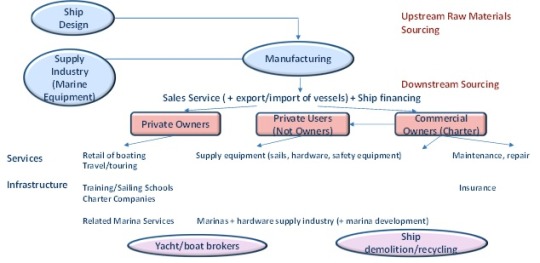
Request for the PDF Brochure @ https://www.coherentmarketinsights.com/insight/request-pdf/1526
Segment Information:
The market in North America is expected to exhibit the highest CAGR during the forecast period. This growth is attributed to high adoption of powered catamaran in developed economies such as the U.S. and Canada.
Furthermore, various international shows conducted in this region could also aid in growth of the market. For instance, Seawind Catamarans (Australia-based) launched Seawind 1260 catamaran at the Miami International Boat Show, in February 2018. According to North American Sailing Industry Study, 2015 multihulls represented 20% of overall domestic production in 2015 that means one in five sail boats built in North America was a multihull. According to the same study, multihulls unit production increased by 3% in 2015 over 2014.
Key companies
Major players operating in the global Powered Catamaran Marketinclude Sunreef Yachts , Spirited Designs, Leopard Catamarans, Lagoon Catamaran, Fountaine Pajot, Matrix Yachts, Voyage Yachts, TomCat Boats, Robertson and Caine, Gemini Catamarans, WorldCat, Outremer Yachting, Scape Yachts, Seawind Group Holdings Pty Ltd, Alumarine Shipyard, Pedigree Cat ,Inc., Farrier Marine, Catahai Co. Ltd, and Alibi Catamarans.
About Us
Coherent Market Insights is a global market intelligence and consulting organization focused on assisting our plethora of clients achieve transformational growth by helping them make critical business decisions.
What we provide:
Customized Market Research Services
Industry Analysis Services
Business Consulting Services
Market Intelligence Services
Long term Engagement Model
Country Specific Analysis
Contact Us:
Mr. Shah
Coherent Market Insights Pvt.Ltd.
Address: 1001 4th Ave, #3200 Seattle, WA 98154, U.S.
Phone: +1–206–701–6702
Email: [email protected]
#Powered Catamaran Market#coherent market insights#market analysis#market research#business consulting
0 notes
Text
(http://www.MaritimeCyprus.com) M/V Sewol was a ferry that was built by the Japanese company Hayashikane Shipbuilding & Engineering Co. Ltd in 1994. She could carry 921 passengers, or a total of 956 persons, including the crew. She had a legal capacity for 180 vehicles and 154 regular cargo containers. The maximum speed of the ship was 22 knots.
The Sewol was originally known as the Ferry Naminoue between 1994 and 2012, and had been operated in Japan for almost 18 years without any accidents. In 2012, the ship was later bought for ₩11.6 billion (US$11.3 million) by Chonghaejin Marine Company, renamed Sewol, and refurbished. Modifications included adding extra passenger cabins on the third, fourth, and fifth decks, raising the passenger capacity by 117, and increasing the weight of the ship by 239 tons.
After regulatory and safety checks by the Korean Register of Shipping, the ship began her operation in South Korea on 15 March 2013. The ship made three round-trips every week from Incheon to Jeju. In February 2014 it was reported that Sewol again passed a vessel safety inspection by the South Korean Coast Guard following an intermediate survey to ensure the ship remained in a general condition which satisfied requirements set by the Korean Register of Shipping.
On 16 April 2014 Sewol capsized and sank 1.5 kilometres off Donggeochado, Jindo County, South Jeolla Province on a voyage from Incheon to Jeju. At least 295 of those on board died.
The South Korea government’s Board of Audit and Inspection revealed that the Korean Register’s licensing was based on falsified documents. After the incident, the company reported that the ship was carrying 124 cars, 56 trucks, and 1157 tons of cargo. The amount of cargo carried was twice the legal limit.
On 12 February 2015, Kim Kyung-il, the coastguard captain, was sentenced to four years in prison.
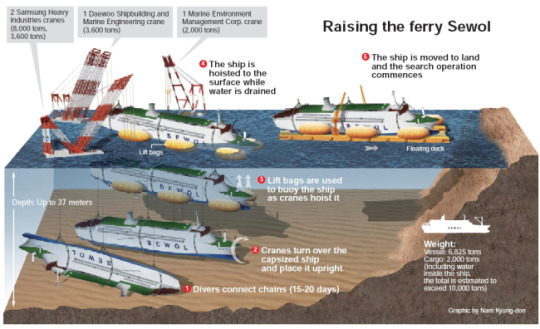
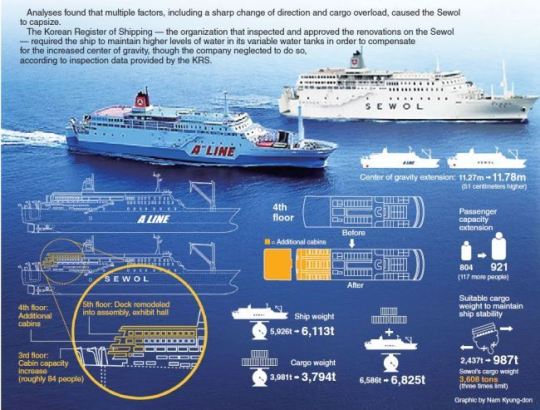
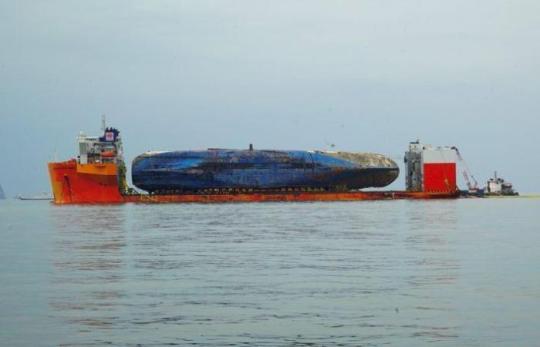
The wreck of the Sewol ferry is carried on a giant heavy-lifting ship after it was raised from the seabed nearly three years after it sank.
SEWOL Salvage Operation:
The operation has completed what was seen as the most difficult part of the massive effort to bring the ship back to shore.
Government officials said it will take a week or two to bring the vessel to a port 90 kilometres away so that investigators could search for the remains of nine missing people, who were among the 304 who died when the Sewol capsized on April 16, 2014.
Most of the victims were students on a high school trip, touching off an outpouring of national grief and soul searching about long-ignored public safety and regulatory failures.
Public outrage over what was seen as a botched rescue job by the government contributed to the recent ouster of Park Geun-hye as president.
“We just got over one hump … we are trying hard to stay calm,” Lee Geum-hee, the mother of a missing school girl, said.
Bringing the Sewol back to the port in Mokpo would be a step toward finding closure to one of the country’s deadliest disasters.
Once the ferry reaches land, government officials said it would take about a month for the ship to be cleaned and evaluated for safety.
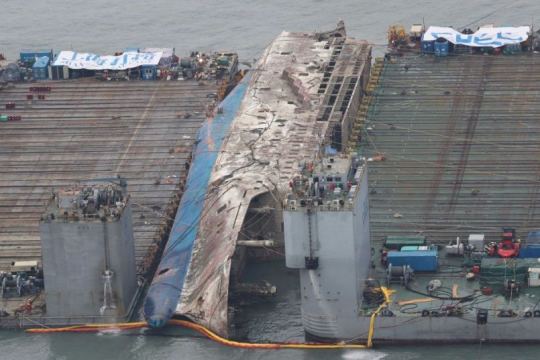
Families demand input into investigation
Investigators will then enter the wreckage and begin a three-month search for the remains of the missing victims and for clues further illuminating the cause of the sinking, which has been blamed on overloaded cargo, improper storage and other negligence.
Relatives of the missing victims, some of whom who were watching from two fishing boats just outside the operation area, cried as the blue-and-white right side of the ferry, rusty and scratched and with its painted name “SEWOL” no longer visible, emerged from the waters on Thursday morning.
A group representing the victim’s families has also demanded that it be part of an investigation committee that will be formed to further study the cause of the ship’s sinking.
The ferry’s captain is serving a life prison sentence for committing homicide through “wilful negligence” because he fled the ship without ordering an evacuation.
July 2020 Update
One of South Korea’s most notorious fugitives was arrested in the United States this week on embezzlement charges at home stemming from the 2014 sinking of a ferry that killed more than 300 people, many of them high school students.
Yoo Hyuk-kee, 48, was arrested on Wednesday without incident at his home in Westchester County, N.Y., in response to an extradition request that South Korea submitted to the United States, a Justice Department spokeswoman said.
Mr. Yoo’s arrest ends a prolonged mystery over the whereabouts of the man South Korean investigators consider to be a central figure in the scandal surrounding the ferry’s sinking, which traumatized the nation. Prosecutors have said that rampant embezzlement by the Yoo family helped create unsafe conditions and practices on the Sewol ferry.
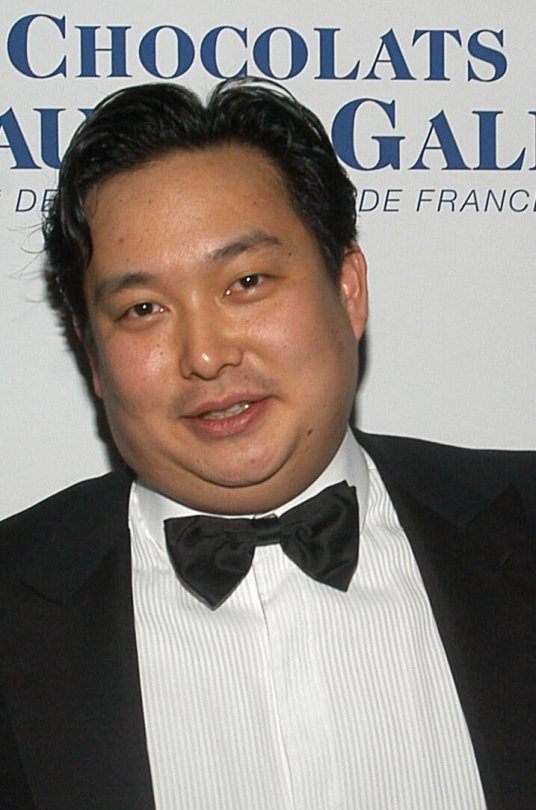
Yoo Hyuk-kee, also known as Keith Yoo.Credit…Jamie McCarthy/WireImage
Mr. Yoo, also known by his English name, Keith Yoo, is a son of Yoo Byung-eun, whose family controlled the Chonghaejin Marine Company, the operator of the Sewol. The overloaded ferry capsized off the southwestern tip of South Korea in April 2014 in the country’s worst disaster in decades.
Prosecutors later said that members of the Yoo family embezzled $169 million from a church that its patriarch helped found and from companies, including Chonghaejin, that were run with church funds and with loyal church members installed as business executives.
By diverting money, which could have been used for safety measures, the family contributed to its sinking, prosecutors said. They also said that the ferry operator had routinely overloaded its ships, including the Sewol, in part to help make up for the losses incurred by the family’s embezzlement. On its last journey, the Sewol was carrying twice as much cargo as it was allowed. In a separate civil trial, a Seoul court in January ordered Mr. Yoo to pay $46 million in damages to the government but ruled that embezzlement was not a direct cause of the ship’s sinking.
The investigation led South Korea to conduct its largest-ever manhunt for the family members.
The senior Mr. Yoo was found dead in an apparent suicide. His eldest son, Yoo Dae-kyoon, spent two years in prison for illegally taking nearly $6.8 million since 2002 from seven companies controlled by his family, including the Chonghaejin company. Other relatives and company executives were also convicted on embezzlement and other criminal charges. The captain of the Sewol, who abandoned ship early in the crisis, is serving a life sentence for murder for his irresponsible handling of the disaster.
But Yoo Hyuk-kee, the patriarch’s second son and once considered the likely heir to his father’s religious and business empire, had been elusive.
He had previously been spotted in the United States, and was known to have owned property in Westchester County. The South Korean authorities asked the U.S. Justice Department for help in apprehending him for eventual extradition.
Mr. Yoo was accused of conspiring with chief executives of the companies controlled by his family to defraud the businesses of $23 million through such sham contracts as “fraudulent” trademark licensing and business consulting agreements, Derek Wikstrom, an assistant U.S. attorney in the Southern District of New York, said in the unsealed complaint against Mr. Yoo.
youtube
Flashback in maritime history: Sinking of M/V Sewol, on 16 April 2014 (www.MaritimeCyprus.com) M/V Sewol was a ferry that was built by the Japanese company Hayashikane Shipbuilding & Engineering Co.
0 notes
Text
Powered Catamaran Market Outlook by Product Overview, Application and Regions 2026
A recent development in design such as configuration fills in niche powered vessels, where the speed and sea kindliness is favored with bulk capacity, has led to introduction of power catamaran. It incorporates features of a motor yacht and combines it with conventional sailing characteristics of a multi-hull. These catamarans are designed with low clearance and significantly with better speed and range than a conventional catamarans. The hulls on the powered catamaran are finer than those of the conventional catamaran, which provides far less resistance.
Download PDF Brochure @ https://www.coherentmarketinsights.com/insight/request-pdf/1526
Powered Catamaran Market Driving Factors
Major factors expected to drive growth of the global powered catamaran market are the benefits offered by these over conventional catamaran. Conventionally, powered catamarans were used for racing or sports purposes, however, over the past few years these have been manufactured for cruising application due to technological advancement such as enhanced speed and safety features coupled with increased stability, which has led to increased adoption of powered catamarans for various applications. Along with sports and cruising, powered catamarans are also been utilized for other applications such as passenger transport and military. Advancements in terms of reliability and enhanced speed and stability such as powerful engines and durable body of the hulls has aided powered catamarans to scale large distance in shorter time periods and offer enhanced comfort and safety. Moreover, it is light weight and offers efficient performance. These are the factors driving powered catamaran market growth.
Powered Catamaran Market Restraint
Major factor expected to restraint growth of the powered catamaran market is stringent environment protection regulations. Stringent government regulation regarding oil and fuel discharge and other harmful chemicals and toxins is among the major factor expected to hinder the global market growth during the forecast period. For instance, according to Federal Refuse Act, the discharge of fuel, oil, oily wastes, and hazardous substances is completely prohibited into the waters of the U.S. or the waters of the contiguous zone. In addition to this, under state law F&GC 5650 prohibits discharges of petroleum and other substances harmful to fish, plants, mammals, and birds.
Powered Catamaran Market Competition Structure
High investment is a major barrier for growth of the industry. A substantial number of powered catamaran manufacturers seem to face cash flow problems and have difficulties financing their business. In this business model, companies need to purchase components and assemble their crafts, before it can be sold as an end product. Hence, manufacturer needs to invest high amount initially for the production. Moreover, volatile demand for these powered catamaran is expected to hamper sale as well as production of these powered catamarans.
Additionally, lack of harmonized registration system is a problem for growth of the market. For example, the U.K. and Germany have a clear national registration system, while the Netherlands lacks such a national system. Owing to this reason, it is difficult to understand the number of boats present in a country, and pay taxes or VAT.
North America Market Accounted for the Largest Share in 2016
On the basis of region, the global powered catamaran market is segmented into North America, Latin America, Europe, Asia Pacific, Middle East, and Africa. The market in North America is expected to exhibit the highest CAGR during the forecast period. This growth is attributed to high adoption of powered catamaran in developed economies such as the U.S. and Canada. These two countries are expected to exhibit high demand for powered catamarans over the forecast period. This growth is attributed to presence of established manufacturers such as Leopard Catamarans in this region. Furthermore, various international shows conducted in this region could also aid in growth of the market. For instance, Seawind Catamarans (Australia-based) launched Seawind 1260 catamaran at the Miami International Boat Show, in February 2018. According to North American Sailing Industry Study, 2015 multihulls represented 20% of overall domestic production in 2015 that means one in five sail boats built in North America was a multihull. According to the same study, multihulls unit production increased by 3% in 2015 over 2014.
Request for Customization @ https://www.coherentmarketinsights.com/insight/request-customization/1526
Key companies
Major players operating in the global powered catamaran market include Sunreef Yachts , Spirited Designs, Leopard Catamarans, Lagoon Catamaran, Fountaine Pajot, Matrix Yachts, Voyage Yachts, TomCat Boats, Robertson and Caine, Gemini Catamarans, WorldCat, Outremer Yachting, Scape Yachts, Seawind Group Holdings Pty Ltd, Alumarine Shipyard, Pedigree Cat ,Inc., Farrier Marine, Catahai Co. Ltd, and Alibi Catamarans.
0 notes
Text
Not even Trump’s trade threats can slow this booming port in a tiny Canadian town
Prince Rupert is hardly the place one would expect to find an international gateway that’s weathering the Trump trade storm better than any other Pacific port in North America.
There’s just one bakery in the town of 12,000 people tucked away in a misty corner of western Canada. The local Walmart outlet is affectionately known as “Smallmart.” Shuttered storefronts on its main street are obstinate reminders of the collapse of its pulp and fishing industries more than a decade ago.
Yet this rainy outpost in British Columbia is the continent’s fastest-growing port for trans-Pacific trade — U.S. President Donald Trump and his tariffs be damned. In the first half of 2018, Prince Rupert’s container volumes surged by 19 per cent from the same period last year, more than any other major gateway for Asian trade in the U.S., Canada or Mexico.
“I would rather call these hiccups,” Maksim Mihic, head of Canada for Dubai-based marine operator DP World Ltd., says of the Trump trade war. His company paid $580 million (US$442 million) three years ago to buy Fairview, Prince Rupert’s upstart container terminal that’s been snatching market share from rival ports like Seattle-Tacoma and Los Angeles. “Whenever you have a trade barrier, there’s opportunity — the market will find a way.”
Port of Prince Rupert unveils expanded terminal, ‘a strategic gem’ for CN Rail
Donald Trump issues fresh auto tariffs threat against Canada if NAFTA talks fail
Port of Vancouver gets $167 million infrastructure investment from Ottawa for three projects
Shippers have discovered Prince Rupert is often the quickest, most reliable, and cheapest route to get everything from Nike sneakers, Microsoft computers and John Deere tractor parts from Asian factories into the U.S. heartland. Empty containers on the return trip, in turn, create an opportunity for Canadian lumber and grain producers to expand exports to the world’s fastest-growing markets. The town’s proximity to Asia is a built-in advantage — up to 58 hours closer by sea than any other North American gateway — which for ships traversing the route can mean roughly one additional round-trip voyage a year.
In 2017, Prince Rupert’s port-wide volumes surged 28 per cent to a record 24 million tons. DP World’s $200 million expansion readied Fairview to accept the largest vessels at sea, which are increasingly favored by shippers seeking to load more containers to reduce costs. Within months, the facility welcomed the largest ship to ever dock at a Canadian port — the Himalayas which, if vertical, would tower over Canada’s tallest building.
“We expect it’ll be another record year,” says Shaun Stevenson, the port’s chief executive officer. “We represent that opportunity for industries to pivot and look at the Asia-Pacific region.”
A Canadian Coast Guard patrol vessel sits at the Port of Prince Rupert in Prince Rupert, British Columbia. The port is the continent’s fastest-growing port for trans-Pacific trade.
At the 24-hour container terminal, massive cranes soaring as high as a 20-story building pluck steel boxes off a ship onto a line of trucks below. Nearby, rail cars wait on track laid directly on the dock by Canadian National Railway Co., whose 20,000-mile network connects the Pacific coast, the Atlantic, and the Gulf of Mexico. The ship-truck-rail transfer is so seamless — unhampered by the urban congestion plaguing larger rivals like Vancouver — that two trains of goods can already be on their way before a vessel is fully unloaded.
From Prince Rupert, it’s a 90-hour shot to Chicago mostly on a natural downgrade through Canada’s sparsely populated interior, meaning rail cars rattle their way to the distribution heartlands of America faster than over any other competing route. So precise and consistent is the path — Microsoft says it can track arrivals almost to the minute — that the technology giant at times has shipped Chinese imports bound for California via Chicago rather than through a California port. In the other direction, exports of containers stuffed with grains — a deviation from the traditional bulk method of pouring grains directly into ships at specialized terminals — are booming.
“The advantage is that you can deliver the container to every corner of the market in Asia,” says Mihic. Instead of committing to a shipload of pulses, an Indian buyer can order 20 tons of lentils for distribution to local mom-and-pop shops, he says. “That is the advantage for Canadian exporters — that’s the untouched territory for us. It’s much more flexible.”
Still, some aren’t convinced that Trump’s trade battles with China, Europe and Canada won’t hamper port shipments at some point. Port officials across the region “don’t want to think that tariffs will expand beyond those already in place and that even those tariffs will be unwound fairly soon,” says Jock O’Connell, a international trade consultant and adviser to Los Angeles-based Beacon Economics. “I’m not that optimistic.”
“Any port that serves as a major conduit for the supply chains that link the U.S. and China ought to be concerned about declines in the volume of trade — and the Port of Prince Rupert fits that description,” he said.
In Prince Rupert, signs of apprehension are hard to find.
In June — just days after Trump first threatened tariffs on US$200 billion worth of Chinese imports after earlier extending steel tariffs to Canada and Mexico — DP World committed to boosting the terminal’s capacity by another third by 2022. Meanwhile, CN Rail is investing $340 million in 2018 to support that growth with more capacity.
Prince Rupert’s prominence has been a long time coming. Its extraordinary positioning was spotted in the early 1900s but its ambitions were cut short when its principal backer — Charles Melville Hays, the railroad tycoon who laid the groundwork for the critical link underpinning it today — died aboard the Titanic in 1912.
“The beginning of our town was a failed dream,” says Mayor Lee Brain, who’s getting calls daily from companies seeking to set up logistics, container-stuffing and warehouse businesses near the port. “It took a hundred years but now we are the Asia-Pacific gateway for intercontinental trade.”
The town’s future may now be tied to a metal container. While tariffs and commodity cycles can strike grain, coal and oil terminals, global container traffic is surging as shippers seek to cram more products into the giant, Lego-like cubes that make freight easier and cheaper to handle. In fact, Trump risk aside, containerization has likely been a bigger driver of globalization than free trade in the post-Second World War era, boosting trade by as much as 1,240 per cent, according to one study in the Journal of International Economics.
“‘Peak container’ isn’t on the horizon,” a McKinsey & Co. report declared last October, saying container traffic was likely to grow as long as the global economy keeps growing. “Indeed, the flexibility of the container trade makes it resilient: one product may go out of fashion but another will come along to fill the box.”
Meanwhile, signs of prosperity are cropping up in Prince Rupert. The town recently saw its first near-$1 million home — a 4,960-square-foot residence perched on a bluff overlooking one of the world’s deepest natural harbours, according to Nikki Morse, a local realtor. The mayor says so many residents are renovating their homes that the municipal landfill is running out of space. “There are more Audis, BMWs and Mercedes driving around than in probably 30 years,” says Stevenson, the port CEO.
Bloomberg.com
from Financial Post https://ift.tt/2P6HLb9
via IFTTT Blogger Mortgage
Tumblr Mortgage
Evernote Mortgage
Wordpress Mortgage
href="https://www.diigo.com/user/gelsi11">Diigo Mortgage
0 notes
Link
PlayStation VR launched exactly one year ago today, and it’s already delivered well over 100 unique experiences, ranging from the delightful to the horrifying and just about everything in between. As we celebrate PS VR’s first birthday, we wanted to give you a peek behind the curtain. Below, you’ll find a list of all the games currently announced to be coming to the platform through the end of the year (and into early 2018).
With virtual reality, you have to put on the headset and feel what it’s like to get the full experience. Head to your local retailer and strap on a PS VR headset, then come back here and let us know what you think in the comments.
Thank you for an excellent first year of PlayStation VR; we can’t wait for you to experience what’s next.
Coming in 2017
Bravo Team
SIE WWS
Supermassive Games (Tumble VR, Until Dawn: Rush of Blood) is creating an intense first-person shooter for single player or online two-player co-op*. The setting is a fictional Eastern European city, and after the president is assassinated, teamwork will be essential for you to survive. Bravo Team will make you feel like you’re in an action movie.
* Active PS Plus membership required.
Doom VFR
Bethesda
id Software’s classic franchise levels up to give players a fully immersive experience. You’re the last known survivor of a demon attack on a Martian research facility. Well, you’re the last human survivor… and you’ll have plenty of opportunity to meet some of the other survivors. Can you take back control of the outpost and send the beasties back to… uh, H-E-double-hockey-sticks?
Gran Turismo Sport
SIE WWS
Each release in the Gran Turismo series becomes the new benchmark in realistic auto-racing games, and that bar is about to be raised — big time. With PS VR, you’ll feel like you’re in the driver’s seat, increasing the immersion to new heights. Learn more here.
Megaton Rainfall
Pentadimensional
Ever dreamed of being an indestructible superhero with the ability to fly at supersonic speeds? Ever fantasized about saving Earth from an alien invasion? Well, it’s time to wake up and get to it. Take on the attacking aliens — who can morph into various forms, including buildings — and evolve your superpowers. But be careful… you may leave more than a little mess behind while you’re defending humanity.
Moss
Polyarc Games
One of E3 2017’s brightest stars was Quill, a young mouse who awakens an ancient magic and sets off on an epic journey to save her uncle. The world of Moss is a gorgeous expanse filled with myth and magic, but there’s little time to savor the view. You’ll need to explore your surroundings and literally manipulate the world as you do whatever you can to assist Quill on her adventure.
No Heroes Allowed!
SIE WWS
In this immersive real-time strategy game, you play the God of Destruction. You ultimately seek world domination… but first you’ll need to find, feed, and breed monsters who’ll do your bidding. Invade human bases, fortify your defenses and carefully build your beastly ecosystem, and soon you may conquer all!
Obduction
Cyan
From the creators of Myst comes a science-fiction adventure filled with mystery, intrigue, and discovery. You find yourself transported off Earth to an alien world…but one that’s populated with pieces of Earth from various locations and times. Don’t spend too much time admiring the beautiful landscapes, though, because you need to find a way back home.
Pixeljunk VR: Dead Hungry
Q-Games
It’s well-known that zombies are always on the hunt for human flesh… but that’s only because they don’t know how to cook a juicy burger and whip up a frosty shake on their own. As a fearless food-truck cook, you’ll need to use your kitchen magic to save the world from disaster and distract the incoming zombie horde with nutritious noms.
Stifled
SIE WWS
Stifled is a unique horror game where you can only reveal your surroundings by creating sound waves–either by throwing nearby objects or speaking into the headset’s built-in mic. Keep in mind, however, that any noise you make may also reveal your location to the grotesque creatures that are lurking in the darkness…
The Elder Scrolls V: Skyrim VR
Bethesda
One of the most popular and ambitious open-world action RPGs ever made will now be even more immersive, thanks to a reimagining in PS VR. You’re the Dragonborn, and you’ll need to master swords and spells to survive the many threats you’ll encounter. Skyrim VR includes the critically acclaimed core game as well as the official add-ons: Dawnguard, Hearthfire and Dragonborn, as well as multiple controller options.
The Inpatient
SIE WWS
The premise is the stuff of nightmares: You’re a patient in the Sanatorium and suffering from amnesia, so your main goal is to unearth your memories–to discover who you are and why you’re there. However, you’ll also reveal a conspiracy at the facility that complicates your efforts to get your life back. Multiple endings up The Inpatient’s replayability, too.
Other Upcoming 2017 Titles
Anamorphine
Ark Park
Brain Voyagers
Chernobyl
CoolpaintVR
CubeWorks
Discovery
DragonBlast VR
Dream Angling
Drunkn Bar Fight
DWVR
End Space
Everest VR
Fishing Master
Flatline: Experience the Other Side
Ghosts in the Toybox
Hex Tunnel
Honor & Duty
Hopalong: The Badlands
Justice League VR
Light Tracer
Monster of the Deep: Final Fantasy XV
Nothin’ But Net
Prana
Quar Infernal Machines
Radial-G: Racing Revolved
RadianVR
Rec Room
Run Dorothy Run
Sculptrvr
Serious Soccer
Shooty Fruitie
Snow Fortress
Stardrone VR
Super Amazeballs
Survios
The Rabbit Hole
The Solus Project
Virtual Engagement Confronting Fears
VirtuGO
VR Apocalypse
Coming in 2018
Golem
Highwire Games
Golem, a PS VR exclusive, places you in a storybook world where you see through the eyes of and take control over stone creatures in order to discover the connection between your family and the mysterious Endless City you’re in. Along the way, you’ll find hidden treasure and valuable artifacts, while honing your melee skills to battle the Silent Watch, a band of hostile golems.
The American Dream
Samurai Punk Pty Ltd.
The American Dream is billed as a satirical VR trip through a 1950’s World’s Fair where guns are a part of the daily routine, including flipping burgers on the grill and assembling them for customers at your job; opening a can for a drink; and even watering plants, weeding and landscaping around your beautiful home; and other activities.
Torn
Aspyr
Torn, a mystery inspired by such classics as The Twilight Zone, is set in the Vermont forest where you discover a house full of secrets. What you find in there are numerous experiments, inventions, gear and documentation that reveal a lot about the doctor who lived there–however they’re also remnants of a man who’s been missing for 64 years.
Xing: The Land Beyond
White Lotus interactive
Right out of the gate, this first-person puzzle-adventure title tells you that you’re dead. Guess you’re off to a bad start, right? From there, you go at your own pace in an entertaining trek through the afterlife, with the story revealed mostly through poetry. It promises to be a unique game suitable for new and veteran VR adventurers alike.
Other 2018 Titles
Alvo
Ariel
Blasters of the Universe
Chainman
Cold Iron
Dead Secret
Dragonflight VR
Drone Fighters
Dungeon Chess
End of the Beginning
Knockout League
Penn & Teller VR: Frankly Unfair, Unkind, Unnecessary and Underhanded (including Desert Bus)
Pixel Ripped 1989
from RSSMix.com Mix ID 8258822 http://ift.tt/2iajXqA
0 notes
Text
(http://www.MaritimeCyprus.com) M/V Sewol was a ferry that was built by the Japanese company Hayashikane Shipbuilding & Engineering Co. Ltd in 1994. She could carry 921 passengers, or a total of 956 persons, including the crew. She had a legal capacity for 180 vehicles and 154 regular cargo containers. The maximum speed of the ship was 22 knots.
The Sewol was originally known as the Ferry Naminoue between 1994 and 2012, and had been operated in Japan for almost 18 years without any accidents. In 2012, the ship was later bought for ₩11.6 billion (US$11.3 million) by Chonghaejin Marine Company, renamed Sewol, and refurbished. Modifications included adding extra passenger cabins on the third, fourth, and fifth decks, raising the passenger capacity by 117, and increasing the weight of the ship by 239 tons.
After regulatory and safety checks by the Korean Register of Shipping, the ship began her operation in South Korea on 15 March 2013. The ship made three round-trips every week from Incheon to Jeju. In February 2014 it was reported that Sewol again passed a vessel safety inspection by the South Korean Coast Guard following an intermediate survey to ensure the ship remained in a general condition which satisfied requirements set by the Korean Register of Shipping.
On 16 April 2014 Sewol capsized and sank 1.5 kilometres off Donggeochado, Jindo County, South Jeolla Province on a voyage from Incheon to Jeju. At least 295 of those on board died.
The South Korea government’s Board of Audit and Inspection revealed that the Korean Register’s licensing was based on falsified documents. After the incident, the company reported that the ship was carrying 124 cars, 56 trucks, and 1157 tons of cargo. The amount of cargo carried was twice the legal limit.
On 12 February 2015, Kim Kyung-il, the coastguard captain, was sentenced to four years in prison.
The wreck of the Sewol ferry is carried on a giant heavy-lifting ship after it was raised from the seabed nearly three years after it sank.
SEWOL Salvage Operation:
The operation has completed what was seen as the most difficult part of the massive effort to bring the ship back to shore.
Government officials said it will take a week or two to bring the vessel to a port 90 kilometres away so that investigators could search for the remains of nine missing people, who were among the 304 who died when the Sewol capsized on April 16, 2014.
Most of the victims were students on a high school trip, touching off an outpouring of national grief and soul searching about long-ignored public safety and regulatory failures.
Public outrage over what was seen as a botched rescue job by the government contributed to the recent ouster of Park Geun-hye as president.
“We just got over one hump … we are trying hard to stay calm,” Lee Geum-hee, the mother of a missing school girl, said.
Bringing the Sewol back to the port in Mokpo would be a step toward finding closure to one of the country’s deadliest disasters.
Once the ferry reaches land, government officials said it would take about a month for the ship to be cleaned and evaluated for safety.
Families demand input into investigation
Investigators will then enter the wreckage and begin a three-month search for the remains of the missing victims and for clues further illuminating the cause of the sinking, which has been blamed on overloaded cargo, improper storage and other negligence.
Relatives of the missing victims, some of whom who were watching from two fishing boats just outside the operation area, cried as the blue-and-white right side of the ferry, rusty and scratched and with its painted name “SEWOL” no longer visible, emerged from the waters on Thursday morning.
A group representing the victim’s families has also demanded that it be part of an investigation committee that will be formed to further study the cause of the ship’s sinking.
The ferry’s captain is serving a life prison sentence for committing homicide through “wilful negligence” because he fled the ship without ordering an evacuation.
youtube
Flashback in maritime history: Sinking of M/V Sewol, on 16 April 2014 (www.MaritimeCyprus.com) M/V Sewol was a ferry that was built by the Japanese company Hayashikane Shipbuilding & Engineering Co.
0 notes
Text
(http://www.MaritimeCyprus.com) M/V Sewol was a ferry that was built by the Japanese company Hayashikane Shipbuilding & Engineering Co. Ltd in 1994. She could carry 921 passengers, or a total of 956 persons, including the crew. She had a legal capacity for 180 vehicles and 154 regular cargo containers. The maximum speed of the ship was 22 knots.
The Sewol was originally known as the Ferry Naminoue between 1994 and 2012, and had been operated in Japan for almost 18 years without any accidents. In 2012, the ship was later bought for ₩11.6 billion (US$11.3 million) by Chonghaejin Marine Company, renamed Sewol, and refurbished. Modifications included adding extra passenger cabins on the third, fourth, and fifth decks, raising the passenger capacity by 117, and increasing the weight of the ship by 239 tons.
After regulatory and safety checks by the Korean Register of Shipping, the ship began her operation in South Korea on 15 March 2013. The ship made three round-trips every week from Incheon to Jeju. In February 2014 it was reported that Sewol again passed a vessel safety inspection by the South Korean Coast Guard following an intermediate survey to ensure the ship remained in a general condition which satisfied requirements set by the Korean Register of Shipping.
On 16 April 2014 Sewol capsized and sank 1.5 kilometres off Donggeochado, Jindo County, South Jeolla Province on a voyage from Incheon to Jeju. At least 295 of those on board died.
The South Korea government’s Board of Audit and Inspection revealed that the Korean Register’s licensing was based on falsified documents. After the incident, the company reported that the ship was carrying 124 cars, 56 trucks, and 1157 tons of cargo. The amount of cargo carried was twice the legal limit.
On 12 February 2015, Kim Kyung-il, the coastguard captain, was sentenced to four years in prison.
The wreck of the Sewol ferry is carried on a giant heavy-lifting ship after it was raised from the seabed nearly three years after it sank.
SEWOL Salvage Operation:
The operation has completed what was seen as the most difficult part of the massive effort to bring the ship back to shore.
Government officials said it will take a week or two to bring the vessel to a port 90 kilometres away so that investigators could search for the remains of nine missing people, who were among the 304 who died when the Sewol capsized on April 16, 2014.
Most of the victims were students on a high school trip, touching off an outpouring of national grief and soul searching about long-ignored public safety and regulatory failures.
Public outrage over what was seen as a botched rescue job by the government contributed to the recent ouster of Park Geun-hye as president.
“We just got over one hump … we are trying hard to stay calm,” Lee Geum-hee, the mother of a missing school girl, said.
Bringing the Sewol back to the port in Mokpo would be a step toward finding closure to one of the country’s deadliest disasters.
Once the ferry reaches land, government officials said it would take about a month for the ship to be cleaned and evaluated for safety.
Families demand input into investigation
Investigators will then enter the wreckage and begin a three-month search for the remains of the missing victims and for clues further illuminating the cause of the sinking, which has been blamed on overloaded cargo, improper storage and other negligence.
Relatives of the missing victims, some of whom who were watching from two fishing boats just outside the operation area, cried as the blue-and-white right side of the ferry, rusty and scratched and with its painted name “SEWOL” no longer visible, emerged from the waters on Thursday morning.
A group representing the victim’s families has also demanded that it be part of an investigation committee that will be formed to further study the cause of the ship’s sinking.
The ferry’s captain is serving a life prison sentence for committing homicide through “wilful negligence” because he fled the ship without ordering an evacuation.
youtube
Flashback in maritime history: Sinking of M/V Sewol, on 16 April 2014 (www.MaritimeCyprus.com) M/V Sewol was a ferry that was built by the Japanese company Hayashikane Shipbuilding & Engineering Co.
0 notes
Text
(http://www.MaritimeCyprus.com) M/V Sewol was a ferry that was built by the Japanese company Hayashikane Shipbuilding & Engineering Co. Ltd in 1994. She could carry 921 passengers, or a total of 956 persons, including the crew. She had a legal capacity for 180 vehicles and 154 regular cargo containers. The maximum speed of the ship was 22 knots.
The Sewol was originally known as the Ferry Naminoue between 1994 and 2012, and had been operated in Japan for almost 18 years without any accidents. In 2012, the ship was later bought for ₩11.6 billion (US$11.3 million) by Chonghaejin Marine Company, renamed Sewol, and refurbished. Modifications included adding extra passenger cabins on the third, fourth, and fifth decks, raising the passenger capacity by 117, and increasing the weight of the ship by 239 tons.
After regulatory and safety checks by the Korean Register of Shipping, the ship began her operation in South Korea on 15 March 2013. The ship made three round-trips every week from Incheon to Jeju. In February 2014 it was reported that Sewol again passed a vessel safety inspection by the South Korean Coast Guard following an intermediate survey to ensure the ship remained in a general condition which satisfied requirements set by the Korean Register of Shipping.
On 16 April 2014 Sewol capsized and sank 1.5 kilometres off Donggeochado, Jindo County, South Jeolla Province on a voyage from Incheon to Jeju. At least 295 of those on board died.
The South Korea government’s Board of Audit and Inspection revealed that the Korean Register’s licensing was based on falsified documents. After the incident, the company reported that the ship was carrying 124 cars, 56 trucks, and 1157 tons of cargo. The amount of cargo carried was twice the legal limit.
On 12 February 2015, Kim Kyung-il, the coastguard captain, was sentenced to four years in prison.
The wreck of the Sewol ferry is carried on a giant heavy-lifting ship after it was raised from the seabed nearly three years after it sank.
SEWOL Salvage Operation:
The operation has completed what was seen as the most difficult part of the massive effort to bring the ship back to shore.
Government officials said it will take a week or two to bring the vessel to a port 90 kilometres away so that investigators could search for the remains of nine missing people, who were among the 304 who died when the Sewol capsized on April 16, 2014.
Most of the victims were students on a high school trip, touching off an outpouring of national grief and soul searching about long-ignored public safety and regulatory failures.
Public outrage over what was seen as a botched rescue job by the government contributed to the recent ouster of Park Geun-hye as president.
“We just got over one hump … we are trying hard to stay calm,” Lee Geum-hee, the mother of a missing school girl, said.
Bringing the Sewol back to the port in Mokpo would be a step toward finding closure to one of the country’s deadliest disasters.
Once the ferry reaches land, government officials said it would take about a month for the ship to be cleaned and evaluated for safety.
Families demand input into investigation
Investigators will then enter the wreckage and begin a three-month search for the remains of the missing victims and for clues further illuminating the cause of the sinking, which has been blamed on overloaded cargo, improper storage and other negligence.
Relatives of the missing victims, some of whom who were watching from two fishing boats just outside the operation area, cried as the blue-and-white right side of the ferry, rusty and scratched and with its painted name “SEWOL” no longer visible, emerged from the waters on Thursday morning.
A group representing the victim’s families has also demanded that it be part of an investigation committee that will be formed to further study the cause of the ship’s sinking.
The ferry’s captain is serving a life prison sentence for committing homicide through “wilful negligence” because he fled the ship without ordering an evacuation.
Flashback in maritime history: Sinking of M/V Sewol, on 16 April 2014 (www.MaritimeCyprus.com) M/V Sewol was a ferry that was built by the Japanese company Hayashikane Shipbuilding & Engineering Co.
0 notes